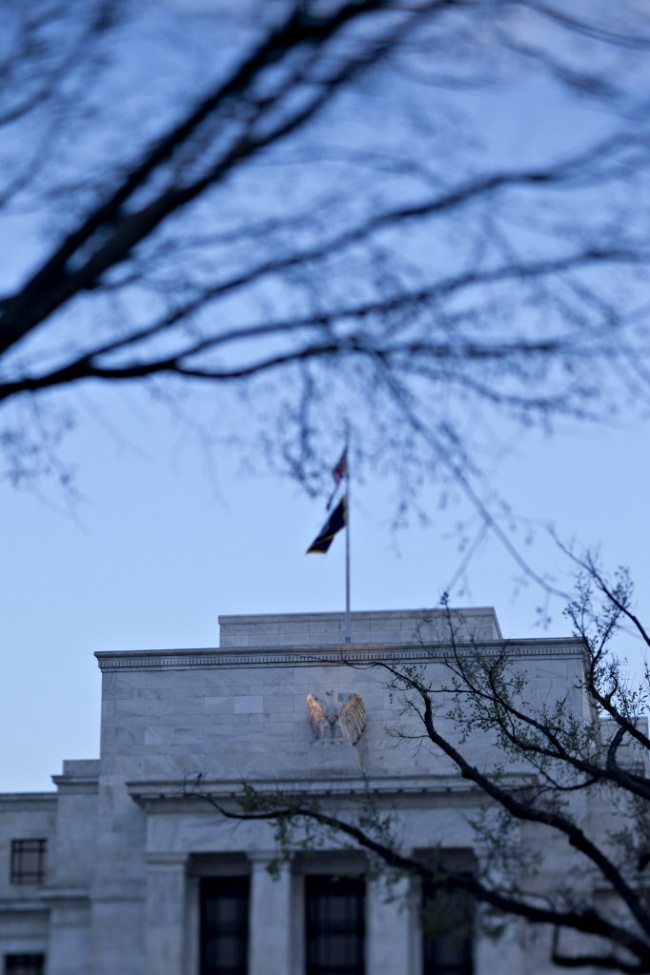WASHINGTON (AP) ― When the Federal Reserve issues a policy statement after it meets this week, the financial world will be on high alert for two words: “Considerable time.”
The presence or absence of that phrase will trigger a rush to assess the likely timing of the Fed’s first increase in interest rates since it cut them to record lows in 2008.
The Fed’s recent statements have said it expects to keep its key short-term rate near zero for a “considerable time” after it stops buying Treasurys and mortgage bonds. Those bond purchases have been intended to keep long-term rates down to support the economy.
But the purchases are set to end in November, so the Fed may soon see the need to use some phrasing other than “considerable time” to signify when it might start raising rates. It could sub out that phrase in this week’s statement. Or it could wait until its next meeting in October.
 |
The Marriner S. Eccles Federal Reserve building in Washington, D.C. (Bloomberg) |
Whatever the statement says when the Fed’s two-day meeting ends Wednesday, Chair Janet Yellen will be pressed when she meets with reporters later to clarify the Fed’s intentions.
Most economists think the Fed will raise rates starting around mid-2015. But as the U.S. economy has strengthened, speculation has intensified about whether it might do so sooner, perhaps by March.
With job growth solid, manufacturing and construction growing and unemployment at a near-normal 6.1 percent, many analysts think the Fed is edging closer to a rate increase to prevent a rising economy from igniting inflation. If so, it might send such a signal by dropping “considerable time” and substituting other language to suggest a likely rate hike by early 2015.
On the other hand, the Fed could drop “considerable time” but substitute vaguer language suggesting it might wait longer to raise rates than many expect. Yellen has cautioned that the drop in unemployment may overstate the job market’s improvement. She has said the Fed also takes into account the number of people unemployed for more than six months; the number of part-timers who want full-time work; and average wages. Those measures remain less than healthy.
Whatever the Fed’s intentions, some economists think it will make no major changes in its policy statement for now.
“All the trend lines for the economy look pretty good right now,” said Mark Zandi, chief economist of Moody’s Analytics. “I don’t think the Fed wants to upset the apple cart.”
Over the past several years, the Fed’s ultra-low rates have helped the economy, cheered the stock market and shrunk mortgage rates. A rate increase could threaten to reverse those trends.
In August, U.S. employers added just 142,000 jobs, well below the 212,000 average of the previous 12 months. The slowdown was seen as likely temporary. But some analysts say it underscored that the economic outlook may remain too hazy for the Fed to signal an earlier-than-expected rate hike.
The Fed was reminded last year that markets are highly sensitive to signals about the end of a prolonged period of low rates. In June 2013, when Chairman Ben Bernanke suggested that the Fed might start slowing its bond purchases before year’s end, the stock market plunged over two days. And bond rates headed up, slowing the housing recovery and jolting developing countries that had benefited from ultra-low U.S. rates.
“The adverse market reaction last year really did scare the Fed,” said Diane Swonk, chief economist at Mesirow Financial. “For that reason, they are treading cautiously now.”
Those who think the Fed will modify the “considerable time” language this week point to recent comments from some officials. For example, Charles Plosser, president of the Fed’s Philadelphia regional bank, dissented at the last Fed meeting in July because he opposed the continued use of the “considerable time” phrase. He said it didn’t reflect progress the economy has made toward the Fed’s goals.
Plosser is among the Fed’s “hawks” ― those who worry that super-low rates will stoke inflation or fuel asset bubbles.
With some hawks as well as doves expressing unease about the Fed’s use of “considerable time,” some analysts say the Fed could tweak the language this week even at the risk of jolting markets.
“The Fed has been a major player in supporting the rise in the stock market, and that makes the markets highly sensitive,” said David Jones, the author of a new history of the Fed. “But if the Fed doesn’t start to signal the coming end of extremely low rates, the markets will keep rallying and the correction will be even sharper when it does come.”
Jones expects the Fed to drop the “considerable time” language. He also thinks it will modify its statement’s reference to “significant underutilization of labor resources” to note the strengthening job market. He expects the first rate increase by March.
But David Wyss, a former Fed economist who teaches at Brown University, said he still foresees June as the most likely time.
“Things are going pretty good now, but there is still an awful lot that can go wrong,” Wyss said. “June 2015 is still the best guess for the first rate hike.”








